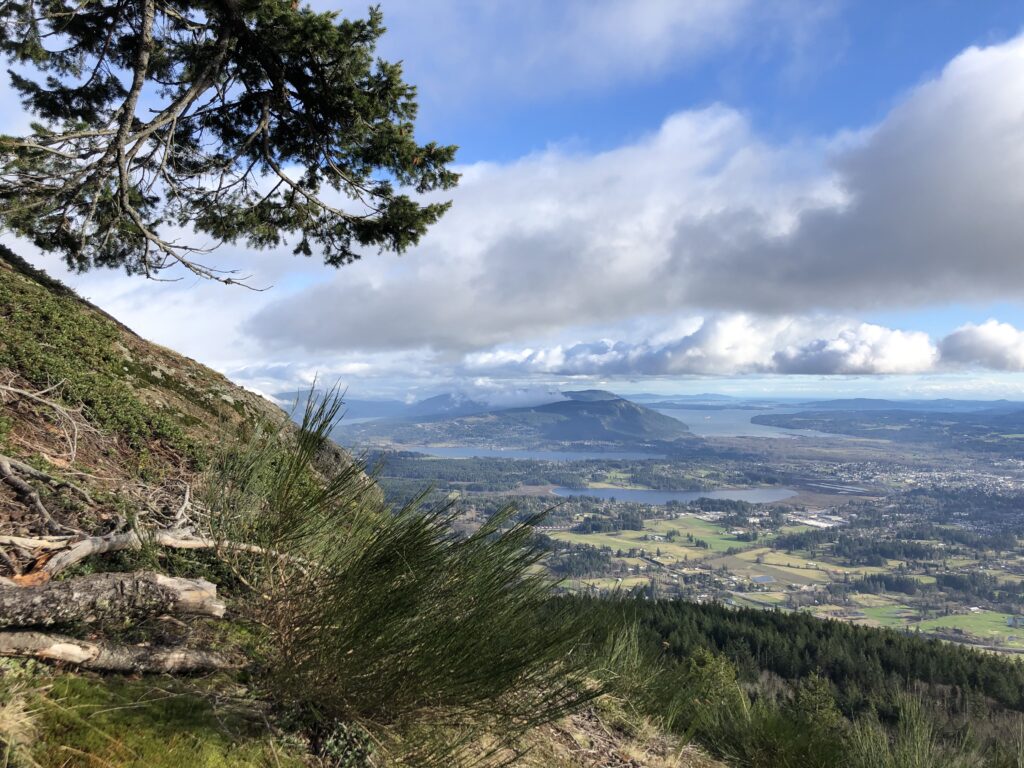
Faults in the fault line: Experts assess Canada’s West Coast disaster risk
December 5, 2022
By
Haley Nagasaki
Tanya Patterson and Kari Tyler offer holistic guidance from Victoria, B.C.
 View overlooking Vancouver Island's Cowichan Valley from the vantage of Mount Prevost. Photo: Annex Business Media
View overlooking Vancouver Island's Cowichan Valley from the vantage of Mount Prevost. Photo: Annex Business Media Throughout 2021, Canada’s West Coast endured some of the most newsworthy natural disasters in the country’s recent history, breaking records with the heat dome of late spring as a one-in-1000-year outlier event.
With incidents of drought, wildfires and flooding on the rise, the need to grow the young emergency management field presents as an urgent reality, coupled with an increased focus on the long-term planning of climate recovery and disaster risk reduction.
Last month, Vancouver hosted the Emergency Preparedness and Business Continuity Conference where discourse surrounding the coast’s vulnerability was discussed at length. Tanya Patterson, the emergency program co-ordinator for the City of Victoria, presented on the topic of a holistic approach to climate adaptation and extreme weather response.
“It was kind of ironic,” she says, because, “unfortunately, there was an extreme weather event happening in Victoria on the first day of the conference, so I spent most of my time in my hotel room working.”
Temperatures dipped below freezing overnight – a rare occurrence in November for temperate south Vancouver Island. “So, we had to organize our staffing and set up warming centres,” Patterson reports, for those living outdoors without shelter or access to resources.
Patterson’s task as emergency program co-ordinator goes above and beyond discerning the root cause of disasters and attempting to mitigate and prevent them from happening. Her team must also assess potential hazards and vulnerabilities, including structural vulnerabilities of housing and infrastructure in addition to social and economic vulnerabilities. Any potential risk must then be addressed for the purposes of mitigation, response and recovery.
Earthquakes represent the greatest risk to Victoria. The city’s risk factor is often modelled after Christchurch, New Zealand, where past seismic events demonstrate tangible outcomes for devastating events of a similar magnitude here in Canada.
The city conducted a seismic vulnerability analysis by sampling different soil types beneath buildings, determining their different modes of construction, as well as the year in which these buildings were built – whether they were pre or post seismic code. The report mapped the most vulnerable locations, highlighting tsunami inundation zones and areas vulnerable to flooding.
The city responded with a tax incentive program for seismic retrofits, Patterson explains, such as the installation of quake bolts to secure houses to their foundations in anticipation of a one-in-three chance of a damaging earthquake in the next 50 years, or fewer.
Public education is part of the team’s mandate, in addition to informing governing bodies responsible for funding to “build back better.” That is, moving to new locations rather than rebuilding in the same flood-prone areas – a phenomenon experienced much to the chagrin of the Halalt First Nations in the Cowichan Valley last year when coastal flooding destroyed the homes and businesses of evacuees who had rebuilt just a few years earlier following a similar flood.
The notion of a holistic approach to climate adaptation and response involves collaborating with organizations, subject matter experts and people involved in creating “mitigation plans that are actually going to be sustainable, as part of the Sendai framework for disaster risk reduction,” Patterson says. “And not just see the same flooding over and over again like we did last year.”
Ties to global warming
Temperature is what drives the climate, and the events that are now occurring with increased frequency and severity correlate to the overall warming of global temperatures.
With the current planetary warming of 1 C, teetering on 2 C projected within the next 20 years, comes the continued devastation of natural disasters, as experts have noted, compounded by the faltering of Band-Aid solutions, like the dikes and dams in the Fraser Valley.
The topic of climate change is especially relevant to Kari Tyler, user engagement and training specialist at the Pacific Climate Impacts Consortium (PCIC) out of the University of Victoria. Tyler has an extensive background working in climate change adaptation and resilience building both in Canada and internationally. Her area of expertise is in disaster risk reduction, looking at the mathematical and scientific statistics of climate change.
PCIC acts as a regional climate service provider, which has climate data “downscaled from global climate models to regionally relevant datasets,” she says, “and does computationally intensive analysis on an ensemble of multiple global climate models.”
In the short term, the most significant piece of data revolves around the earth’s warming temperature. Tyler explains how the climate is warmer now than it was in the 1980s and even the most recent historical data “describes a climate that we are no longer in.”
The challenge with risk assessment is that the likelihood of future events is calculated with better certainty only after rare events occur. The silver lining of B.C.’s last tumultuous years has been the collection of data accrued on the likelihood of future events, leading to more accurate projections and, in theory, the ability to prepare accordingly.
From coast to coast, Canadians are being buffeted by extreme weather events, and the reality is that these events will only continue. Researchers note that a stabilized climate depends on the ability to achieve net-zero carbon emissions followed by a 10-year stabilization period where weather patterns would readjust to its current degree of warmth, rather than returning to the homeostasis of generations past.
The one-in-1000-year events that, over the coming decades, will occur in as little as one-in-five years, signals a new class of one-in-1000-year events in magnitudes difficult to comprehend, explains Tyler. Therefore, the evolution of practice must now take place at all levels of mitigative planning because it’s not a matter of if, but when.
In late November, the federal government introduced its proposed National Adaptation Strategy with established targets to help prepare for and recover from the impacts of climate change. Over the next five years, $1.6 billion will be made available to address extreme heat, the risk of wildfires, and flooding – the costliest of all environmental implications to date.
The adaptation strategy will also distribute resources to the Disaster Mitigation and Adaptation Fund as well as the Federation of Canadian Municipalities’ Green Municipal Fund.
As Patterson and Tyler have both identified, the new reality in which we live calls for the need to do things differently. It is an opportunity to do better work and to merge reconciliation with resilience. “Whether we anticipate climate change or we’re just reacting to it, this is going to be expensive,” says Tyler. “But it’s going to be cheaper if we anticipate it.”
Allocating capital and human efforts to the pursuit of holistic thinking and integrative solutions appears to be the best course of action. While nuances are to be expected, “we now know the general direction in which the climate is changing; the data is there,” Tyler affirms.
Statistics will continue to clarify over time, similar to our adaptive learning techniques, but overall, we are well equipped to make changes in the planning and design of any sector within Canada.

Tanya Patterson, emergency program co-ordinator for the City of Victoria.

Kari Tyler, user engagement and training specialist at the Pacific Climate Impacts Consortium.
Print this page